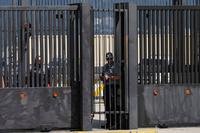Junior soldiers at the Army's garrison in Hawaii are now allowed to move out of their barracks after 20 weeks of pregnancy, a potentially huge step forward as the Army doesn't have a service-wide norm and most garrisons don't allow pregnant troops to move out until much later.
The move, approved this month by Col. Steve McGunegle, the Army Garrison Hawaii commander, reduced how far along in a pregnancy a soldier must be before potential permission to leave the barracks from 28 weeks. That 28-week mark is the norm for most Army installations, though some push the requirement to as late as 32 weeks.
That garrison comprises 22 sites, including Schofield Barracks, Wheeler Army Airfield and Fort Shafter.
Read Next: Air Force Ends BEAST Week Mock Deployment at Boot Camp
"[This] was updated to reduce risks to the mother and baby, and provide ample time to find a residence, furnish a home and be settled before delivery," Michael Donnelly, a spokesperson with U.S. Army Garrison Hawaii, told Military.com in a statement.
There is no blanket Army rule that governs when pregnant junior troops can earn the additional benefits generally associated with married service members, specifically being granted a housing allowance and permitted to live off base. The move comes as senior Army officials, most notably Sergeant Major of the Army Michael Grinston, have urged commanders and senior noncommissioned officers not to wait for service-wide personnel policies to improve quality of life for their soldiers.
One of the key factors in the new policy in Hawaii is permitting women to move before a soldier enters her third trimester of pregnancy to give room for a possible premature baby and allow the soldier to be more comfortable in the final months before giving birth, one soldier familiar with how the new rule was developed told Military.com. It also gives those soldiers more wiggle room if there is a delay in their housing allowance or there are issues finding housing.
The Army as a whole has put parenthood issues at the center of some of its policy revamps this year, a signal that women have made significant gains in boosting their foothold in the service. The service has effectively revamped quality-of-life issues pertaining to the 400,000 parents serving, including better accommodations for women pumping breast milk while on duty, and expanding leave options for miscarriages.
Editor's note: This story has been updated to clarify what areas the Hawaii garrison encompasses.
-- Steve Beynon can be reached at Steve.Beynon@military.com. Follow him on Twitter @StevenBeynon.
Related: The Female Soldier Insurgency that Helped Rewrite the Army's Rules on Parenthood












